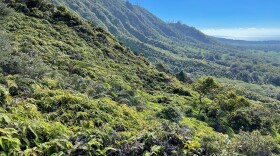'Apapane are the most abundant Hawaiian honeycreeper. Scientists estimate that there are over a million individuals throughout the state — about one 'apapane per person in Hawai‘i.
Like the 'amakihi, 'apapane appear to be developing a genetic resistance to mosquito-borne avian malaria, which has helped them sustain their numbers. However, they are still vulnerable to habitat loss and predation.

'Apapane can be found on all the main Hawaiian Islands. They are in much lower numbers on Lana'i, where they are the sole remaining honeycreeper.
Although 'apapane prefer cooler climates above 3,000 feet in elevation, they will venture to lower levels in native forests if 'ōhi'a lehua are in bloom. These ruby-red honeycreepers have brush-tipped tongues in order to sip nectar from native flowers.
Small flocks of 'apapane will fly together from tree to tree to feed, which helps them evade more territorial birds like the 'i'iwi.
'Apapane’s songs are composed of more than 400 different syllables, and they sing continually during the day, creating a wonderful chorus throughout the canopy.
Read about and hear other Hawaiian birds on our Manu Minute page.





